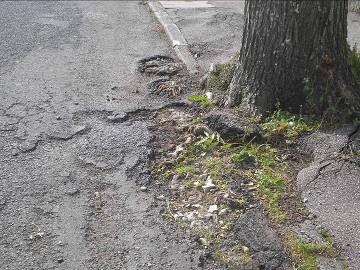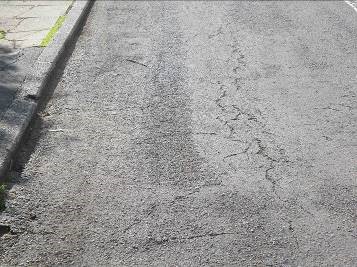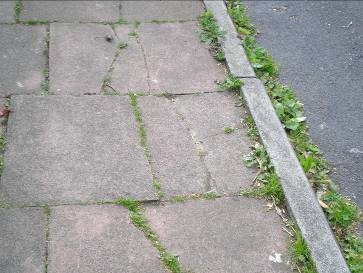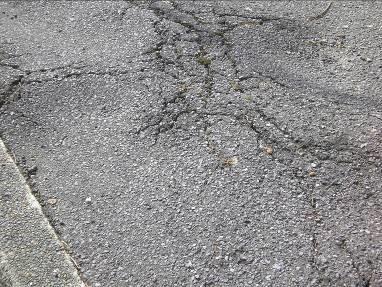Highway Asset Management Plan and Strategy 2019-2023
Contents
- Lead member statement
- Summary
- Introduction
- User expectations and demands
- Service standards
- Carriageways
- Footways
- Street lighting
- Highway structures
- Risks to the plan
Lead member statement
Reading’s roads are vital to the economic and social prosperity of the borough. They are an integral part in our daily lives. Whether it be travelling to work, going to school, working or enabling us to make the most of our free time it almost always involves using a road or footway.
It is essential that the Council maintains our highways safely to an appropriate standard and for a reasonable cost, not just now but into the future. We must therefore plan for both our immediate and long-term needs and maintain them accordingly.
This Highway Asset Management Plan and Strategy (HAMP) is an important element of how the Council plans to meet these challenges. It is the output from a process of planning and analysis of short and longer-term needs.
This plan sets out the Council’s plans for the management of the Council’s Highway Asset for the next 5 years. It has been produced in accordance with national guidance and recommended good practice.
The plan recognises the views of our local road users and residents and the demands that are placed upon our assets including factors that we cannot control such as the effect of harsh winter weather.
The plan illustrates the Council’s commitment to deliver a network that is safe to use, and capable of ensuring that the economic wellbeing of Reading is supported by a well-maintained road network.
This plan was created and approved in 2019. Shortly after this the Council committed to investing an additional £9m over 3 years to improve the condition of roads and footways in the borough. The plan has been updated to reflect this.
Councillor Tony Page – Deputy Leader, Reading Borough Council and Lead Member for Strategic Environment, Planning & Transport
Summary
The Council’s strategies for the highway asset for the period 2019 to 2024 are:
Carriageways: Classified Roads; maintain condition within the targets
- Annual funding of approx. £1m will be invested in resurfacing and treatment of surfaces
- This will allow treatment (resurfacing or surface treatment) of approximately 11 km of road each year
Carriageways: Unclassified Roads; improve condition to progress towards targets
- Annual funding of approx. £2.3m will be invested in resurfacing and treatment of surfaces
- This will allow treatment (resurfacing or surface treatment) of approximately 29 km of road each year
Carriageways: Repair of defects: meet standards for repair of defects (potholes)
- Annual funding of approx. £135k on the repair of carriageway and footway defects
- Repair defects to current standard, repairing approx. 2,200 per annum
Footways: improve condition with the increased investment to progress towards targets
- Annual funding of approximately £500k p.a. will be invested in resurfacing footways
- This will allow treatment (resurfacing) of approximately 12.5 km of footway each year
Street Lighting: repair defects promptly and replace life expired columns
- Annual funding of approximately £300k p.a. will be invested in street lighting maintenance
- This will allow reactive and routine of approximately 600 lighting defects pa and
- Removal of any life-expired columns identified by structural testing
Structures: reduce the number of structures in a poor or very poor condition
- Annual funding of approximately £500k
- Investment of £4m is targeted at improving the condition of structures currently assessed to be in a very poor or poor condition
The additional funding invested in carriageways is going to lead to an improved asset. To maintain the level achieved will require continued annual investment of £1.6m.
1. Introduction
This document sets out the Council’s plan and strategies for the Council’s highway assets for the period 2019-2023.
Purpose
The purpose of this document is to define the service standards that users can expect and to explain the strategies to be implemented to achieve these standards.
Context
The plan and strategies have been developed in accordance with relevant national guidance and standards applied to support wider Council plans and strategies.
The standards and targets are based upon assumed level of future spending. If actual budgets differ significantly from these levels the standards in the plan may need to be revised
Progress Reporting
Progress in delivering the plan and the effectiveness of the strategies will be monitored. A status report will be produced annually detailing if the target standards are being met or not. Based on this report managers and members will approve required updates to the plan or the strategies.
The Highway Assets
The highway assets included in this plan are carriageways, footways, bridges and culverts, streets lights, traffic signs, bollards, drainage gullies and street furniture.
The plan does not cover bus stops private roads and bridges, Council owned bridges, not on or crossing the highway network and decorative or seasonal lighting
Data
The plan is based upon available asset data, which for some assets is currently limited. Where data deficiencies exist, the plan has been based upon sample surveys or local estimates. To ensure that future plans are based on more complete information a Data Management and Improvement Plan (2) has been created to support this plan.
2. User expectations and demands
This plan has been based upon a review of user expectations and demands of the asset.
Customer Satisfaction
The Council participates in the National Highways and Transportation (NHT) survey. The survey enables the Council to gauge the level of user satisfaction with highways. The survey allows us to compare with other authorities and track how opinions of the service provided are changing.
The survey indicates that levels of satisfaction with highway maintenance are similar to national averages. The greatest lowest level of satisfaction both nationally and locally is with the condition of highways.

Comparing the results with last years indicates a minor improvement in satisfaction overall. Improvement in satisfaction levels with the condition of highways is indicated although this is still at a low level of satisfaction (34%)

Customer Contacts
Customer contacts about the highway assets are recorded in the Council’s customer relationship management system. Data on the number of contacts with the Council is not readily available at the time of creating this plan. Systems improvements are in hand that will allow statistics to be included in future updates of this plan.
Asset Growth
In the last 5 years 1 km of new carriageways along with associated assets have been added to the asset. These will create need for maintenance and associated funding in future years.
3. Service standards
To define what service standards users can expect.
Standards for each asset have been set with reference to:
- Safety
- The number of incidents/defects requiring an immediate (3hr) response [R1e repairs]
- The number of defects requiring a (24hr) response [R1 repairs]
- The number of defects requiring a 7-day response [R2a repairs]
- The number of defects requiring a (28 day) day response [R2 repairs]
- Condition
- The percentage of the asset in a “poor” condition (red condition)
- The percentage of the asset that is “in need of maintenance” (amber condition)
- The number of minor defects (programmed works/repairs) [R3 repairs]
Inspection and reactive repair standards are set out in the Council’s highway maintenance manual. This plan assumes those standards will be consistently met. The specific standards that users can expect from each highway asset group during the plan period are shown in section 5.
Strategies
Strategies will be applied to achieve the target standards. The strategy for each asset group is given in the section below. The strategies include predictions of the types and quantities of works required to deliver the service standards. The strategies involve prioritising repair or replacement of elements of each asset in a manner designed to achieve the standard at the best possible short and long-term cost.
Works Programmes
The strategies will be used to create programmes of works. Lists of potential works are maintained for each asset based on the results of inspection and condition surveys. These lists are used to derive works programmes which are published annually on the Council’s website.
Funding Assumptions
The standards included in the plan are based upon the levels of funding indicated. Significant changes in these funding levels would result in the standards in the plan needing to be revised.
Carriageways
Standards
The strategy for carriageways comprises of investment in resurfacing treatments and continued repair of defects. The aim is to prevent the asset deteriorating below the targets set out below.
| Priority | Action | Response time | Compliance | Anticipated quantity ## |
|---|---|---|---|---|
| Priority | Action | Response Time | Compliance | 250 |
| R1e# | Make safe or undertake an emergency repair with 3 hours following receipt of instruction (including weekends and Bank Holidays). | 3 hrs | 99% | 2000 |
| R1 | Repair or make safe within 24 hours following receipt of order (including weekends and Bank Holidays) | 24 hrs | 99% | 2000 |
| R2a | Repair within 7 days following receipt of order (calendar days) | 7 days | 99% | 2000 |
| R2 | Repair within 28 days following receipt of order (calendar days) | 28 days | 99% | 2000 |
## typical annual quantities
Defects are categorised for repair based upon their type, size and location and allocated a priority from those shown above. # The definition of defects for carriageways are given in the maintenance manual.
Condition
| Road class | Classified roads (A, B, C) | Unclassified roads |
|---|---|---|
| Red – poor condition | Shall be kept below 5% | Shall be kept below 5% |
| Amber – deteriorating condition | Shall be kept below 25% | Shall be kept below 35% |
Roads in a deteriorating (amber) condition comprise of those with major deterioration where resurfacing is required and those at an early stage of deterioration where a treatment of the surface will provide a cost effect way of preventing deterioration. Illustrative examples of these conditions are shown below.

Poor condition: red 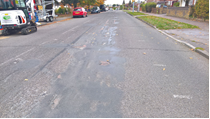
Deteriorating condition (major): amber 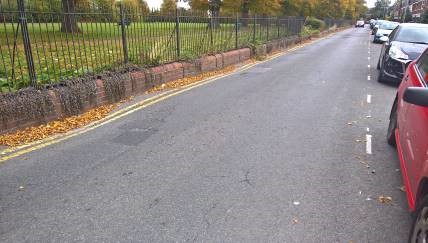
Deteriorating condition (minor): amber
Strategies
Repair of Carriageway Defects
Defects such as potholes and the like are identified by a regime of inspection or notified to the Council by users. Defects are assessed based upon the risk they pose to users and their repair prioritised in accordance with the Council’s maintenance manual and policy.
- Routine and reactive repairs are expected to continue at current levels throughout the period of this plan.
This plan assumes that the works crews deployed to repair defects will continue to do so and that the quantities of repair required will be similar to those experienced in recent years.
Resurfacing and Surface Treatment
To keep defects at a manageable level, lengths of road require resurfacing or surface treatment. Treatment is required when their condition deteriorates to the point where defects are occurring. The extent of this is reflected in the condition targets shown previously. The strategy for carriageways in relation to measured condition is:
- Maintain Classified Roads in a Steady (current) State: Continued investment in A B and C roads with the intention of maintaining current condition. The A, B and C roads are in an acceptable condition. They do however require ongoing investment order for them to be maintained at this level.
- Unclassified Road Condition: Maintain to above target standard. The level of funding available currently is insufficient to prevent deterioration of unclassified roads. Council will target available funding to mitigate against deterioration as effectively as possible with the aim of condition progressing towards the target levels specified above.
Works
The strategy above is expected to require the following amounts of works to be undertaken.
Routine and Reactive Repair
- repairing approximately totals of 250 R1& R1e defects and
- approximately 2,000 R2, defects annually
Planned maintenance
| Road class | A, B, C | U |
|---|---|---|
| Surface Treatment (Preventative Maintenance) | 20km | 69km |
| Resurfacing (Corrective Maintenance) | 12km | 19km |
Annual Works Programme
A rolling programme is maintained of all roads where maintenance should be considered. A prioritisation process documented in the Council’s highway maintenance manual is used to create an annual programme of work that is approved by Council and published.
The prioritisation process ensures that the strategy is implemented and that there is a documented method for choosing which schemes get completed first.
Funding Assumptions
The works quantities detailed above have been estimated based upon the following anticipated funding levels shown below:
| Works Type | Annual Funding Assumed |
| Planned | £3.3m |
| Routine & Reactive | £135k |
4. Footways
The strategy for footways comprises increased investment in resurfacing combined with the continued repair of minor defects.
Standards
Safety: Repair of Footway Defects
| Priority | Action | Response time | Compliance | Anticipated quantity ## |
|---|---|---|---|---|
| R1e# | Make safe or undertake an emergency repair with 3 hours following receipt of instruction (including weekends and Bank Holidays). | 3 hrs | 99% | 250 |
| R1 | Repair or make safe within 24 hours following receipt of order (including weekends and Bank Holidays) | 24 hrs | 99% | 2000 |
| R2a | Repair within 7 days following receipt of order (calendar days) | 7 days | 99% | 2000 |
| R2 | Repair within 28 days following receipt of order (calendar days) | 28 days | 99% | 2000 |
##typical annual quantities, includes both carriageway and footway defects
Defects are categorised for repair based upon their type, size and location and allocated a priority from those shown above. # The definition of defects for footways are given in the maintenance manual.
Condition
Below 1% of footways will be kept in poor condition (red).
Below 15% of footways will be kept in deteriorating condition (amber).

Poor condition: red 
Deteriorating condition (major): amber 
Deteriorating condition (minor): amber
Strategies
Repair of Footway Defects
Defects such as trips and potholes and the like are identified by a regime of inspection or notified to the Council by users. Defects are assessed based upon the risk they pose to users and their repair prioritised in accordance with the Council’s maintenance manual and policy.
- Routine & reactive repairs are expected to continue at current levels through the period of this plan.
Resurfacing of Footways
Footways to be resurfaced will be identified from condition survey results. Schemes will be prioritised using the method set out in the maintenance manual. In general terms the method aims to prioritise the treatment of worst condition footways.
Works
The strategy above is expected to require the following amounts of works to be undertaken.
Routine and Reactive Repair
- Included in carriageways
Planned Maintenance
Programme of resurfacing/renewal of footways: 38km
Funding Assumptions
The works above following amounts of estimated funding will be required annually.
| Works Type | Annual Funding Assumed |
| Planned | £500k |
| Routine & Reactive | Included in carriageways |
5. Street Lighting
The strategy for street lighting comprises of prompt repair of defects and managing column condition using a regime of non-destructive testing.
Standards
Safety: Repair of Street Lighting Defects
Street lighting defects are repaired in accordance with the regime set out below.
| Type | Intervention criteria | Response time | Target compliance |
|---|---|---|---|
| Safety Defect (Emergency) | Dangerous equipment – exposed wires, missing doors, hanging or fallen brackets, lanterns or other equipment, accident damaged equipment, vandalised equipment, 2 Belisha beacons out a one crossing. | 2 hours | 100% |
| Maintenance Defect (High) | Lantern out, rotated bracket, leaning column, column loose in the ground, lantern twisted | 5 working days | 100% |
| Maintenance Defect (Low) | Missing number, column needs repainting or cleaning, minor defects. | 28 days (following issue of PO) | 100% |
Condition
As a result of recent investment, the street lighting asset is in a good condition. The new LED lanterns should require minimal maintenance during the term of the plan. The condition of columns will be assured via a regime of non-destructive structural testing. The results of the testing will be monitored to ensure that the Council can continue to replace any columns found to be near the end of their useful lives before they present a risk of collapse. The following standard will be adopted.

| Condition category | Description | Action | Target compliance |
|---|---|---|---|
| Poor | The unit has serious rusting and paint flaking and possible minor mechanical deformation | Removed within 3 months of test result | 100% |
| Bad (Fail/Remove) | The unit has considerable rusting and paint flaking has noticeable deformation or holes and is considered to be in a dangerous condition | Replaced within 1 week of the test result | 100% |
Strategies
- Defects identified via routine inspection or public notification will be promptly repair in accordance with the standards shown above
- The lighting column structural testing programme is enabling columns in bad or poor condition to be identified and replaced prior to failure.
Works
The strategy detailed above is expected to require the following amounts of works to be undertaken.
Routine and Reactive Repair
It is expected that current levels of approximately 600 maintenance defects p.a. of a variety of priority levels will be required to be repaired
Column replacement
Replace up to 150 columns pa based upon results of non-destructive structural testing
Funding Assumptions
To enable the amounts of works detailed above to be carried out the funding shown will be required:
| Works | Approximate Annual Funding Assumed £k |
|---|---|
| Reactive Maintenance | 150 |
| Testing | 20 |
| Energy | 650 |
| Column Replacement | 175 |
6. Highway Structures
The strategy for highway structures comprises of the targeted refurbishment of structures in a very poor or poor condition combined with a regime of routine maintenance designed to prevent other structures deteriorating into a poor condition.
Standards
Repair of structure defects
Defects that meet the criteria for intervention will be addressed using the same regime as for roads. Structure defects of this nature are rare. Damage to structure from vehicle impact do occur from time to time and the Council responds by visiting and making the site safe before planning appropriate repairs.
| Priority | Action | Response time | Compliance | Anticipated quantity## |
|---|---|---|---|---|
| Priority | Action | Response Time | Compliance | Anticipated Quantity## |
| R1e# | Make safe or undertake an emergency repair with 3 hours following receipt of instruction (including weekends and Bank Holidays). | 3 hrs | 99% | <10 |
| R1 | Repair or make safe within 24 hours following receipt of order (including weekends and Bank Holidays) | 24 hrs | 99% | <10 |
Condition
Targets for structures condition has not yet been established. The variety of structure types and sizes make it difficult to accurately predict future condition. It is however important that that condition is monitored and used to inform future plans. This will be done by regularly reviewing the condition indicators below. The overall aim will be to improve the condition of the stock from the currently indicated.

Less than 20% of structures will be kept in a very poor condition.
| Class | Standard |
|---|---|
| Red – structures in a very poor condition | Kept below 20 |
| Amber – structures in poor condition that should be considered for maintenance | Kept below 50 |
Strategies
Refurbishment
The Council has identified a long-term list of refurbishment needs that at the time of this plan includes:
- 20 structures in a “very poor” condition (including 6 road bridges)
- 50 structures in a “poor” condition (including 8 road bridges)
- 1 structure identified for parapet upgrading
The strategy for the structures is to prioritise their refurbishment and work through them addressing the worst condition ones first. Opportunity will be taken to bid for additional funding from the DfT when such funding becomes available. Refurbishment schemes will be prioritised using the method set out in the Council’s maintenance manual.
Routine and Reactive Maintenance
Routine maintenance needs differ for each structure type but typically include removal of vegetation, cleaning of drainage and minor repairs to masonry and concrete. An ongoing programme of these works will be deployed to prevent, where possible, greater level of deterioration occurring.
Works
The strategy detailed above is expected to require the following works to be required
Routine and Reactive Repair
Routine and reactive repair needs vary and are identified from inspections. They are collated into work packages to facilitate efficiency of repair, e.g., grouping packages of the same type of work.
Planned Maintenance
It is not appropriate to forecast the number of structures that will be refurbished in each year. Structures are of a variety of sizes, complexity and need. Works on one of two structures may consume the available budget in one year but in other years works will be possible on a greater number of structures.
Funding Assumptions
This plan is based upon the following assumed funding levels for highways structures:
| Works Type | Annual Funding Required |
| Routine & Reactive | £260k |
| Planned | £560k |
7. Risks to the plan
The risks that could prevent achievement of the standards specified in this plan are:
| Plan assumption | Risk | Action if risk occurs |
|---|---|---|
| The plan is based upon winters being normal | Adverse weather will create higher levels of detects and deterioration than have been allowed for. | Budgets and predictions will be revised, and this plan updated if abnormally harsh winters occur. |
| The plan is based upon normal seasonal weather conditions | Adverse weather will create higher levels of detects and deterioration than have been allowed for. | Budgets and predictions will be revised, and this plan updated if abnormally adverse weather (e.g., flooding) occur. |
| Available budgets have been assumed as shown in sections 5 to 9 | External pressures mean that government reduce the funding available for roads | Target service standards will be revised to affordable levels |
| Construction inflation will remain at level similar to the last 5 years. | Construction inflation will increase the cost of works (particularly oil costs as they affect the cost of road surfacing materials) | Target service standards will be revised to affordable levels. |
| Levels of defect and deterioration are based on current data which is limited for some assets (e.g., footways) | Assets deteriorate more rapidly than predicted and the investment required to meet targets is insufficient. | Split between planned and reactive maintenance budgets will be revised. |

